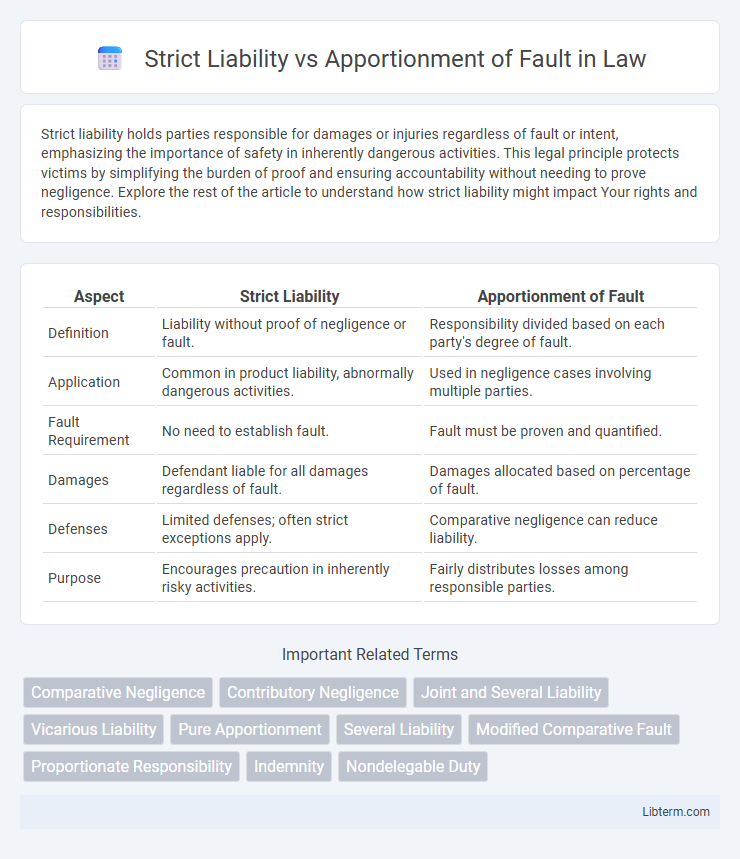Strict liability holds parties responsible for damages or injuries regardless of fault or intent, emphasizing the importance of safety in inherently dangerous activities. This legal principle protects victims by simplifying the burden of proof and ensuring accountability without needing to prove negligence. Explore the rest of the article to understand how strict liability might impact Your rights and responsibilities.
Table of Comparison
| Aspect | Strict Liability | Apportionment of Fault |
|---|---|---|
| Definition | Liability without proof of negligence or fault. | Responsibility divided based on each party's degree of fault. |
| Application | Common in product liability, abnormally dangerous activities. | Used in negligence cases involving multiple parties. |
| Fault Requirement | No need to establish fault. | Fault must be proven and quantified. |
| Damages | Defendant liable for all damages regardless of fault. | Damages allocated based on percentage of fault. |
| Defenses | Limited defenses; often strict exceptions apply. | Comparative negligence can reduce liability. |
| Purpose | Encourages precaution in inherently risky activities. | Fairly distributes losses among responsible parties. |
Understanding Strict Liability in Law
Strict liability in law imposes responsibility for damages or injuries regardless of fault or intent, primarily applied in cases involving inherently dangerous activities or defective products. This legal principle ensures that plaintiffs receive compensation without proving negligence, shifting the burden to defendants. In contrast, apportionment of fault allocates liability based on each party's degree of responsibility, often reducing damages according to contributory negligence.
Definition and Principles of Apportionment of Fault
Apportionment of fault is a legal principle that assigns responsibility among multiple parties based on their respective degrees of negligence or wrongdoing in causing harm. Unlike strict liability, which holds a party fully liable regardless of fault, apportionment requires evaluating each party's contribution to the damage. This principle ensures that damages are allocated proportionally, reflecting the percentage of fault attributed to each defendant.
Key Differences Between Strict Liability and Apportionment of Fault
Strict liability imposes responsibility on a party without requiring proof of negligence or intent, often applied in cases involving inherently dangerous activities or defective products. Apportionment of fault allocates responsibility among multiple parties based on the degree of their negligence or wrongdoing, affecting the amount of damages each party must pay. The key difference lies in strict liability's automatic assignment of fault versus apportionment's proportional allocation based on comparative negligence.
Common Scenarios for Strict Liability Application
Strict liability is commonly applied in scenarios involving inherently dangerous activities, such as blasting, using explosives, or keeping wild animals, where the defendant is liable regardless of negligence or intent. Product liability cases frequently invoke strict liability when manufacturers produce defective or unsafe products that cause harm to consumers. Environmental damage caused by ultrahazardous operations, including chemical spills or hazardous waste disposal, often triggers strict liability to ensure accountability and compensation for affected parties.
The Role of Negligence in Apportionment of Fault
Strict liability imposes responsibility without proof of negligence, whereas apportionment of fault allocates damages based on each party's degree of negligence. In apportionment of fault, negligence determines the percentage of liability assigned to each defendant, directly impacting the compensation awarded. This system ensures that parties who contributed more significantly to the harm bear a proportionate share of the financial burden.
Legal Implications for Plaintiffs and Defendants
Strict liability holds defendants fully responsible for damages without requiring proof of negligence, significantly benefiting plaintiffs by simplifying the burden of proof in product liability and hazardous activities cases. In contrast, apportionment of fault allocates damages based on each party's degree of responsibility, potentially reducing the defendant's financial exposure and complicating plaintiffs' recovery efforts. Legal outcomes under strict liability often result in more predictable plaintiff victories, while apportionment fosters nuanced judgments that balance fault and can mitigate defendant liability.
Comparative and Contributory Fault Doctrines
Comparative fault and contributory fault doctrines are key principles in apportionment of fault that determine liability based on the plaintiff's role in causing harm, with comparative fault allowing damages to be reduced in proportion to the plaintiff's negligence and contributory fault barring recovery entirely if the plaintiff is even minimally at fault. Strict liability imposes responsibility without fault, especially in cases involving abnormally dangerous activities or defective products, making the defendant liable regardless of intent or negligence. Understanding the distinctions between strict liability and fault-based doctrines is essential for accurately assessing legal responsibilities and potential damages in personal injury and tort cases.
Case Studies Demonstrating Both Legal Theories
Case studies involving strict liability often highlight scenarios such as defective product litigation where manufacturers are held fully accountable regardless of negligence, exemplified by the landmark case Greenman v. Yuba Power Products. Apportionment of fault is demonstrated in cases like Li v. Yellow Cab Co., where comparative negligence principles allocate damages based on the percentage of fault among parties. These examples illustrate how courts balance liability either through absolute responsibility or proportional fault allocation to achieve equitable outcomes.
Pros and Cons: Strict Liability vs Apportionment of Fault
Strict liability ensures accountability by holding defendants responsible regardless of intent, simplifying plaintiff recovery but potentially leading to unfair outcomes when fault is minimal. Apportionment of fault allocates damages based on each party's degree of responsibility, promoting fairness but complicating litigation and prolonging dispute resolution. Choosing between strict liability and fault apportionment impacts legal predictability, efficiency, and the equitable distribution of damages in tort claims.
Choosing the Appropriate Standard in Legal Practice
Choosing the appropriate standard between strict liability and apportionment of fault hinges on the nature of the case and jurisdictional statutes. Strict liability imposes responsibility without fault, often applied in product liability or abnormally dangerous activities, ensuring plaintiff protection despite no negligence. Apportionment of fault allocates damages based on each party's degree of responsibility, commonly utilized in negligence cases to promote equitable outcomes and mitigate excessive liability.
Strict Liability Infographic

 libterm.com
libterm.com